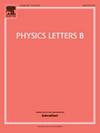Does the Amati correlation exhibit redshift-driven heterogeneity in long GRBs?
IF 4.3
2区 物理与天体物理
Q1 ASTRONOMY & ASTROPHYSICS
引用次数: 0
Abstract
Long gamma-ray bursts (GRBs) offer significant insights into cosmology due to their high energy emissions and the potential to probe the early universe. The Amati relation, which links the intrinsic peak energy to the isotropic energy, is crucial for understanding their cosmological applications. This study investigates the redshift-driven heterogeneity of the Amati correlation in long GRBs. We analyzed 221 long GRBs with redshifts from 0.034 to 8.2, dividing them by redshift thresholds of 1.5 and 2. Using Bayesian marginalization and Reichart's likelihood approach, we found significant differences in the Amati parameters between low and high redshift subgroups. These variations, differing by approximately 2σ at and more than 1σ at , suggest an evolution in the GRB population with redshift, possibly reflecting changes in host galaxy properties. The Akaike and Bayesian Information Criteria also confirm these results. However, selection effects and instrumental biases may also contribute to it. Our results challenge the assumption of the Amati relation's universality and underscore the need for larger datasets and more precise measurements from upcoming missions like Transient High-Energy Sky and Early Universe Surveyor (THESEUS), and enhanced X-ray Timing and Polarimetry mission (eXTP) to refine our understanding of GRB physics.
Amati相关是否在长伽马射线暴中表现出红移驱动的异质性?
长伽马射线暴(GRBs)由于其高能量发射和探测早期宇宙的潜力,为宇宙学提供了重要的见解。将内在峰值能量与各向同性能量联系起来的阿玛蒂关系对于理解它们的宇宙学应用至关重要。本研究探讨了长伽马射线暴中Amati相关的红移驱动异质性。我们分析了221个红移范围从0.034到8.2的长grb,将它们除以红移阈值为1.5和2。使用贝叶斯边缘化和Reichart的似然方法,我们发现低红移和高红移亚组之间的Amati参数存在显著差异。这些变化,在z=1.5时相差约2σ,在z=2时相差超过1σ,表明GRB种群的演化伴随着红移,可能反映了宿主星系性质的变化。赤池和贝叶斯信息准则也证实了这些结果。然而,选择效应和工具偏差也可能起到一定作用。我们的研究结果挑战了Amati关系的普适性假设,并强调了需要更大的数据集和更精确的测量,如瞬态高能天空和早期宇宙探测器(THESEUS),以及增强的x射线计时和偏振测量任务(eXTP),以完善我们对GRB物理的理解。
本文章由计算机程序翻译,如有差异,请以英文原文为准。
求助全文
约1分钟内获得全文
求助全文
来源期刊

Physics Letters B
物理-物理:综合
CiteScore
9.10
自引率
6.80%
发文量
647
审稿时长
3 months
期刊介绍:
Physics Letters B ensures the rapid publication of important new results in particle physics, nuclear physics and cosmology. Specialized editors are responsible for contributions in experimental nuclear physics, theoretical nuclear physics, experimental high-energy physics, theoretical high-energy physics, and astrophysics.
 求助内容:
求助内容: 应助结果提醒方式:
应助结果提醒方式:


